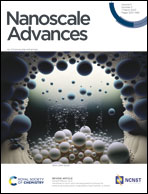Chirality variation from self-assembly on Ullmann coupling for the DBCh adsorbate on Au(111) and Ag(111)†
Abstract
On-surface Ullmann coupling has been considered an appealing approach for the precise fabrication of carbon-based covalent nanostructures under solution-free conditions. However, chirality has seldom been discussed in Ullmann reactions. In this report, self-assembled two-dimensional chiral networks are initially constructed in a large area on Au(111) and Ag(111) after adsorption of the prochiral precursor, 6,12-dibromochrysene (DBCh). Self-assembled phases are then transformed into organometallic (OM) oligomers after debromination, preserving the chirality; in particular, the formation of scarcely reported OM species on Au(111) is discovered herein. With the aryl–aryl bonding induced after intensive annealing, covalent chains are fabricated via the cyclodehydrogenation between chrysene blocks, resulting in the formation of 8-armchair graphene nanoribbons with staggered valleys on both sides. Before chiral polymer chains are constructed by chrysene blocks, the high structural flexibility of OM intermediates on Ag(111) is also revealed during reactions, which is derived from the twofold coordination of Ag atoms and conformationally flexible metal–carbon bonding. Our report not only provides solid evidence of atomically precise fabrication of covalent nanostructures with a feasible bottom-up approach but also sheds insights into the comprehensive investigation of chirality variation from monomers to artificial architectures via surface coupling reactions.

- This article is part of the themed collections: Supramolecular Chirality in Self-organised Systems and Thin Films and Celebrating Nanoscience in China


 Please wait while we load your content...
Please wait while we load your content...